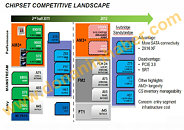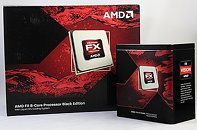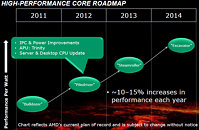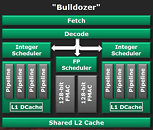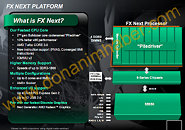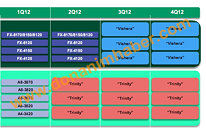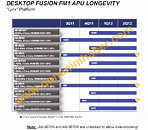
AMD 1090FX and 1070 Chipsets Disclosed, No PCI Express 3.0
AMD is fine-tuning its product development cycle to deliver a new processor architecture towards the end of each year, and a new chipset towards the beginning of one, maintaining platform compatibility and longevity. The company launched its socket AM3+ compliant 9-series chipset months ahead of its first-generation Bulldozer FX processor family, though it looks like in the year 2012 it will launch a new line of desktop chipset, in all likelihood it will precede the launch of second-generation Bulldozer (codenamed "Piledriver") processors.
In 2012, AMD chipset family will be led by the 10-series chipset. At the very top is AMD 1090FX northbridge, followed by 1070. 1090FX will be designed to give out two PCI-Express x16 links, which can then drive up to four graphics cards. The 1070, on the other hand, gives out just one x16 link, which can drive up to two graphics cards. AMD will scrap its present model of 990X and 970, in which the northbridge is essentially the same piece of silicon, with the 990X having lane switches and supporting CrossFireX. A big revelation here is that the 10-series chipset will not feature PCI Express Gen 3.0. We'd normally expect AMD to be at the forefront of supporting new technologies. If we remember, AMD 790FX was the first AMD platform chipset in the industry to feature PCI-Express 2.0. Also, it is highly likely that AMD's Radeon HD 7000 series graphics, which are slated for later this year, will support PCI-Express 3.0 interface.
In 2012, AMD chipset family will be led by the 10-series chipset. At the very top is AMD 1090FX northbridge, followed by 1070. 1090FX will be designed to give out two PCI-Express x16 links, which can then drive up to four graphics cards. The 1070, on the other hand, gives out just one x16 link, which can drive up to two graphics cards. AMD will scrap its present model of 990X and 970, in which the northbridge is essentially the same piece of silicon, with the 990X having lane switches and supporting CrossFireX. A big revelation here is that the 10-series chipset will not feature PCI Express Gen 3.0. We'd normally expect AMD to be at the forefront of supporting new technologies. If we remember, AMD 790FX was the first AMD platform chipset in the industry to feature PCI-Express 2.0. Also, it is highly likely that AMD's Radeon HD 7000 series graphics, which are slated for later this year, will support PCI-Express 3.0 interface.
